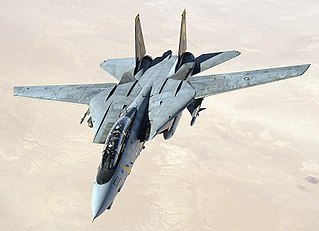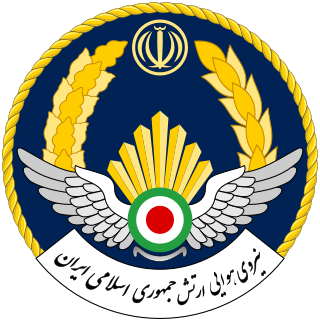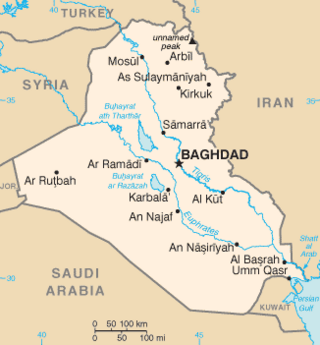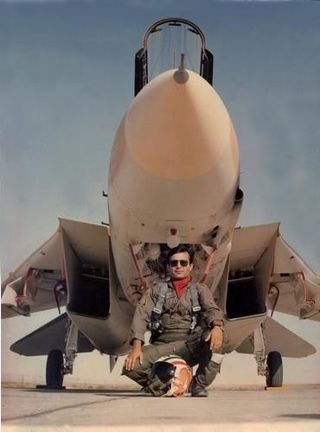
The AIM-54 Phoenix is an American active radar-guided, beyond-visual-range air-to-air missile (AAM), carried in clusters of up to six missiles on the Grumman F-14 Tomcat, its only operational launch platform.

The Grumman F-14 Tomcat is an American carrier-capable supersonic, twin-engine, two-seat, twin-tail, all-weather-capable variable-sweep wing fighter aircraft. The Tomcat was developed for the United States Navy's Naval Fighter Experimental (VFX) program after the collapse of the General Dynamics-Grumman F-111B project. A large and well-equipped fighter, the F-14 was the first of the American Teen Series fighters, which were designed incorporating air combat experience against MiG fighters during the Vietnam War.

The Islamic Republic of Iran Air Force is the aviation branch of the Islamic Republic of Iran Army. The present air force came into being when the Imperial Iranian Air Force was renamed in 1979 following the Iranian Revolution. The IRIAF was heavily involved in the Iran–Iraq War, carrying out major operations like Operation Kaman 99, Operation Sultan 10, the H-3 airstrike, and the first attack on a nuclear reactor in history, Operation Scorch Sword. As a result of eight years of aerial combat in that conflict, the IRIAF has the second highest claimed number of fighter aces in the region, exceeded only by the Israeli Air Force; as many as seven IRIAF pilots claimed more than six kills, mostly achieved in the F-14 Tomcat. Veterans of the Iran–Iraq War would go on to form the core of the IRIAF command.

The history of the Iranian Air Force, currently known as the Islamic Republic of Iran Air Force, can be divided into two phases—before the Islamic Revolution, and after it.
The Grumman F-14 Tomcat has served with the United States Navy and the Imperial Iranian Air Force, then the Islamic Republic of Iran Air Force after 1979. It operated aboard U.S. aircraft carriers from 1974 to 2006 and remains in service with Iran. In-depth knowledge of its service with Iran is relatively limited.
Operation Alborz, more commonly known by the code-name Operation Kaman 99, was an operation launched by the Iranian Air Force in retaliation to Iraqi surprise aerial attacks on Iran the day before which marked the beginning of the 8-year-long Iran–Iraq War. Involving nearly 200 aircraft, it is considered the largest operation carried out by the IRIAF. The outcome was clearly successful, as the Iranians achieved air superiority for the first years of the conflict.

Jalil Zandi was a fighter pilot in the Islamic Republic of Iran Air Force (IRIAF) who served during all of the Iran–Iraq War. His combat record qualifies him as one of the most successful pilots of that conflict in air-to-air combat, as well as one of the most successful Iranian aces ever. It also made him the most successful pilot in the history of the F-14 Tomcat.

Abbas Babaei was an Iranian pilot and brigadier-general in the Islamic Republic of Iran Air Force (IRIAF), during the Iran-Iraq War.

The H-3 airstrike was a surprise air attack by the Iranian Air Force during the Iran–Iraq War on 4 April 1981 against the Iraqi Air Force's H-3 Air Base in western Iraq. The Iranians destroyed at least 48 Iraqi aircraft on the ground with no losses of their own. Based on the results achieved, it is considered one of the most successful raids in the history of aerial warfare.
Kazem Sedghi was an Iranian F-14 Tomcat fighter pilot in the Islamic Republic of Iran Air Force during the Iran–Iraq War. Sedghi has been credited with 5 confirmed aerial victories against Iraqi aircraft during the war, a record that qualifies him as a flying ace.

Operation Sultan 10 was an operation of the Islamic Republic of Iran Air Force (IRIAF) on 29 October 1980, at the beginning of the Iran–Iraq War. In this operation, six F-4E Phantom IIs from IRIAF's 32nd and 33rd Squadrons took part in an attack on the Al-Hurriah Airbase near Mosul in Saddam Hussein's Iraq.

Sedjil is an Iranian semi-active radar homing air-to-air missile. It is made by the Self-Sufficiency Jihad Organization of the Islamic Republic of Iran Air Force and is actually a modified version of the surface-to-air MIM-23 HAWK. The Sedjil weighs approximately 500 kg, its length is 5 meters and its diameter is about 40 cm. The effective range of the missile is approximately 90 km. Its speed is estimated to be about mach 4-5.

Fereidoun Ali-Mazandarani is an Iranian retired fighter pilot and a Grumman F-14 Tomcat flying ace during the Iran–Iraq War.

Abolfazl Mehreganfar is an Iranian retired fighter pilot of Grumman F-14 Tomcat who served during the Iran–Iraq War.

Assadollah Adeli is an Iranian retired fighter pilot on the Grumman F-14 Tomcat who served during the Iran–Iraq War. He was an elite pilot in the Iranian Air Force, and in 1977 he was one of the few pilots in the Imperial Iranian Air Force who were selected to fly the F-14. He flew the aircraft between 1980 and 1988, during the Iran-Iraq war.
Mostafa Roustaei is an Iranian amateur astronomer and retired fighter pilot who flew with Grumman F-14 Tomcat during the Iran–Iraq War. French military historian Pierre Razoux has credited him with 5 aerial victories, a record that qualifies him as a flying ace.
Jamshid Afshar is an Iranian retired fighter pilot who flew with Grumman F-14 Tomcat during the Iran–Iraq War. He has been credited him with 5 or 6 confirmed aerial victories, a record that qualifies him as a flying ace.
Jalil Moslemi is an Iranian retired fighter pilot of Grumman F-14 Tomcat who served during the Iran–Iraq War.
Mohammad Masbouq, was an Iranian fighter pilot on the Grumman F-14 Tomcat who served during the Iran–Iraq War. He was an elite pilot in the Iranian Air Force, and he mainly flew with Assadullah Adeli in the rear cabin as a pilot and radar intercept officer.












